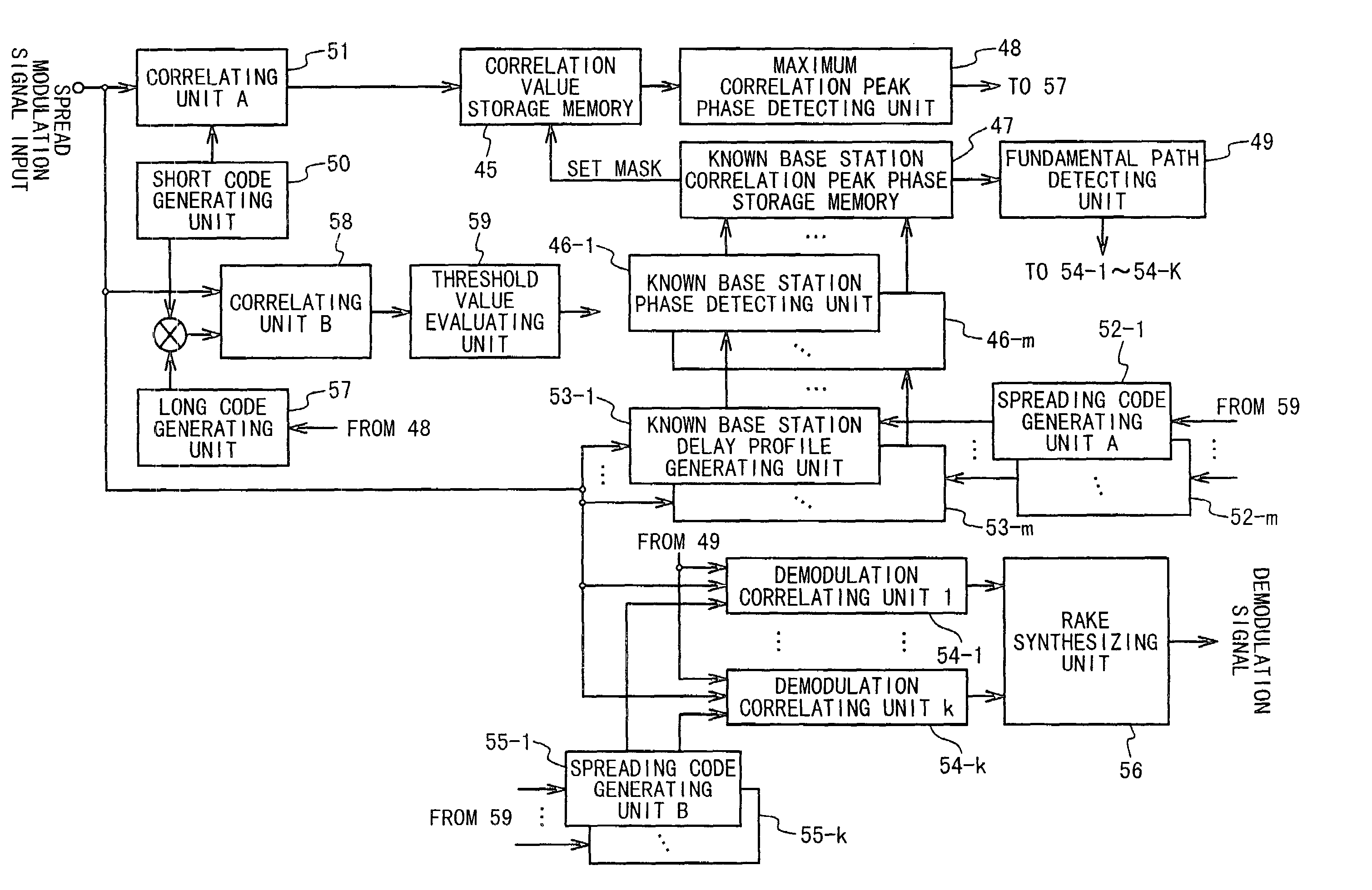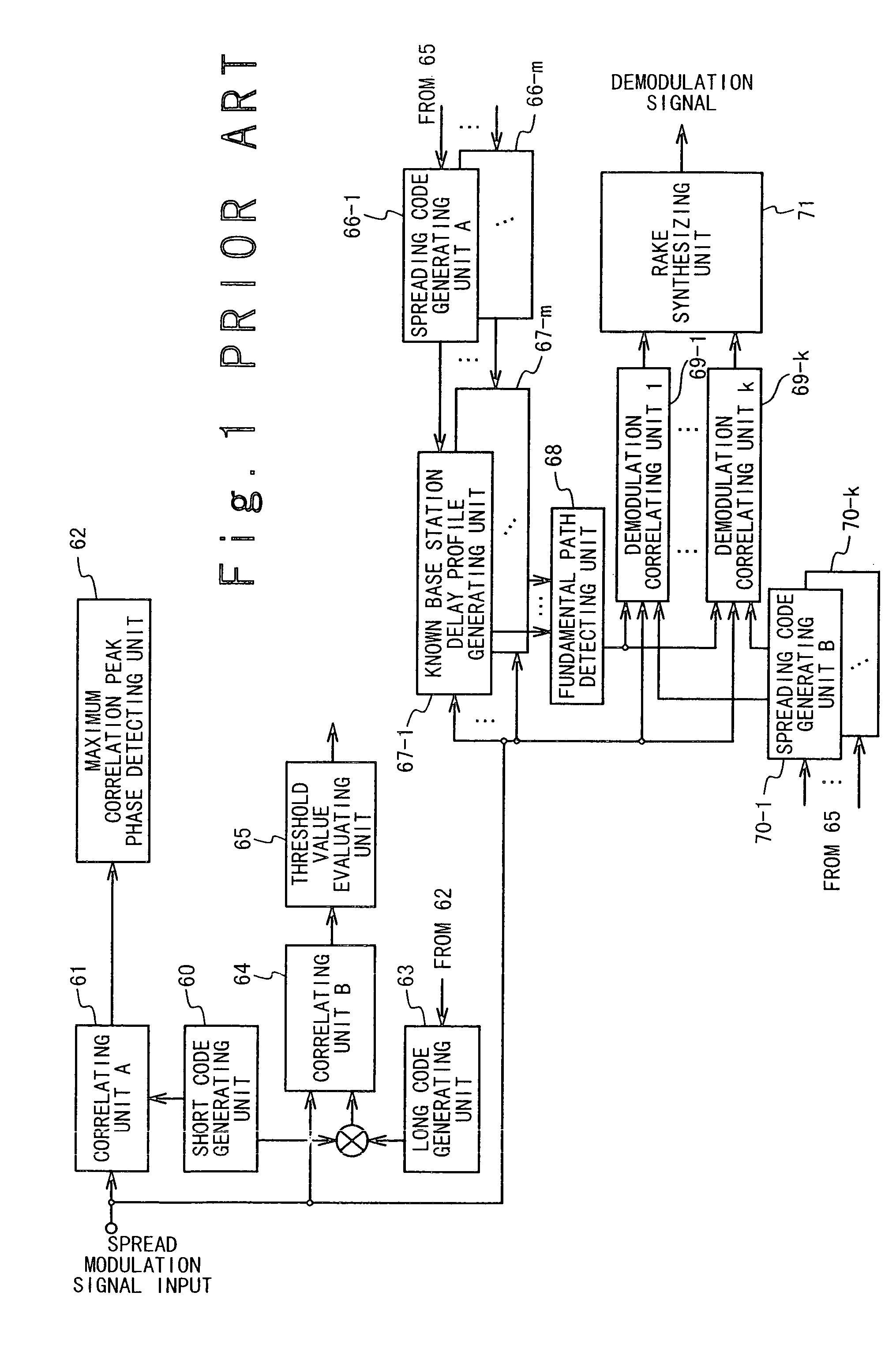CDMA baseband receiver capable of establishing synchronization with peripheral base stations
a baseband receiver and synchronization technology, applied in the direction of synchronisation arrangement, high-level techniques, wireless communication, etc., can solve the problems of deteriorating precision, high search time, and inability to remove the correlation peak phase of known base stations including multi-path propagation components, etc., to achieve short time and high precision
- Summary
- Abstract
- Description
- Claims
- Application Information
AI Technical Summary
Benefits of technology
Problems solved by technology
Method used
Image
Examples
first embodiment
[0052]FIG. 2 is a block diagram showing the structure of a CDMA baseband receiver according to a first embodiment of the present invention. FIG. 3 is a block diagram showing a structural example of a maximum correlation peak phase detecting unit used in the first embodiment. FIG. 4 is a flowchart showing an example of the operation of the maximum correlation peak phase detecting unit used in the first embodiment. FIG. 5 is a view showing an example of the relationship between a long code mask symbol phase and a long code phase. FIG. 6 is a diagram for illustrating a delay profile generated by a known base station delay profile generating unit. FIG. 7 is a diagram showing an example of algorism of the known base station delay profile generating unit used in the first embodiment. FIGS. 8A and 8B are flowcharts showing the procedures of an initial process of synchronizing with a base station in the first embodiment when there is no base station in which synchronization has been establi...
second embodiment
[0095]FIG. 11 is a block diagram showing the structure of a CDMA baseband receiver according to a second embodiment of the present invention. FIG. 12 is a flowchart illustrating the processing of a known base station correlation peak phase detecting unit according to the second embodiment. FIGS. 13A and 13B are flowcharts illustrating the processing of a maximum correlation peak phase detecting unit used in the second embodiment. FIGS. 14A, 14B, and 14C are flowcharts illustrating the procedures of a peripheral cell searching operation carried out when synchronization with one or more base stations is established in the second embodiment.
[0096]As shown in FIG. 11, the CDMA baseband receiver of the second embodiment is mainly composed of known base station correlation peak phase detecting units 17-1 to 17-m, a known base station correlation peak phase storage memory 18, a maximum correlation peak phase detecting unit 19, a short code generating unit 20, a correlating unit A 21, sprea...
third embodiment
[0109]FIG. 15 is a block diagram showing the structure of a CDMA baseband receiver according to a third embodiment of the present invention.
[0110]As shown in FIG. 15, the CDMA baseband receiver of the third embodiment is mainly composed of known base station correlation peak phase detecting units 31-1 to 31-m, a known base station correlation peak phase storage memory 32, a maximum correlation peak phase detecting unit 33, a fundamental path detecting unit 34, a short code generating unit 35, a correlating unit A36, spreading code generating units A 37-1 to 37-m, known base station delay profile generating units 38-1 to 38-m, demodulation correlating units 39-1 to 39-k, spreading code generating units B 40-1 to 40-k, a RAKE synthesizing unit 41, a long code generating unit 42, a correlating unit B 43, and a threshold value evaluating unit 44.
[0111]Of these components, the short code generating units 35, the correlating unit A36, the spreading code generating units A 37-1 to 37-m, th...
PUM
 Login to View More
Login to View More Abstract
Description
Claims
Application Information
 Login to View More
Login to View More - R&D
- Intellectual Property
- Life Sciences
- Materials
- Tech Scout
- Unparalleled Data Quality
- Higher Quality Content
- 60% Fewer Hallucinations
Browse by: Latest US Patents, China's latest patents, Technical Efficacy Thesaurus, Application Domain, Technology Topic, Popular Technical Reports.
© 2025 PatSnap. All rights reserved.Legal|Privacy policy|Modern Slavery Act Transparency Statement|Sitemap|About US| Contact US: help@patsnap.com



